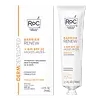What's inside
What's inside
 Key Ingredients
Key Ingredients

 Benefits
Benefits

 Concerns
Concerns

 Ingredients Side-by-side
Ingredients Side-by-side

Water
Skin ConditioningDimethicone
EmollientGlycerin
HumectantCetearyl Olivate
Polyacrylamide
Sorbitan Olivate
EmulsifyingPhenoxyethanol
PreservativeDimethicone/Vinyl Dimethicone Crosspolymer
Skin ConditioningSynthetic Beeswax
Emulsion StabilisingC13-14 Isoparaffin
EmollientDimethiconol
EmollientDimethicone Crosspolymer
Emulsion StabilisingChlorphenesin
AntimicrobialLaureth-7
EmulsifyingCarbomer
Emulsion StabilisingSodium Hyaluronate
HumectantEthylhexylglycerin
Skin ConditioningC12-14 Pareth-12
EmulsifyingSodium Hydroxide
BufferingWater, Dimethicone, Glycerin, Cetearyl Olivate, Polyacrylamide, Sorbitan Olivate, Phenoxyethanol, Dimethicone/Vinyl Dimethicone Crosspolymer, Synthetic Beeswax, C13-14 Isoparaffin, Dimethiconol, Dimethicone Crosspolymer, Chlorphenesin, Laureth-7, Carbomer, Sodium Hyaluronate, Ethylhexylglycerin, C12-14 Pareth-12, Sodium Hydroxide
Butyl Methoxydibenzoylmethane 2%
UV AbsorberHomosalate 5.5%
Skin ConditioningEthylhexyl Salicylate 4.5%
UV AbsorberOctocrylene 4%
UV AbsorberWater
Skin ConditioningButylene Glycol
HumectantOctyldodecyl Neopentanoate
EmollientC14-22 Alcohols
Emulsion StabilisingIsododecane
EmollientGlycerin
HumectantSqualane
EmollientSorbitan Isostearate
EmulsifyingBeta-Sitosterol
Emulsion StabilisingAstragalus Membranaceus Root Extract
EmollientButyrospermum Parkii Butter
Skin ConditioningOleic Acid
EmollientCeramide Ng
Skin ConditioningCeramide NP
Skin ConditioningWithania Somnifera Root Extract
Skin ConditioningGlyceryl Behenate
EmollientAlteromonas Ferment Extract
Skin ConditioningPolyglyceryl-4 Isostearate
EmulsifyingBiosaccharide Gum-4
Skin ConditioningCamellia Sinensis Leaf Extract
AntimicrobialEuphorbia Cerifera Wax
Lecithin
EmollientHydroxyethyl Acrylate/Sodium Acryloyldimethyl Taurate Copolymer
Emulsion StabilisingC12-20 Alkyl Glucoside
EmulsifyingPolyisobutene
PEG-7 Trimethylolpropane Coconut Ether
EmulsifyingTocopherol
AntioxidantEthylhexylglycerin
Skin Conditioning1,2-Hexanediol
Skin ConditioningPhenoxyethanol
PreservativeButyl Methoxydibenzoylmethane 2%, Homosalate 5.5%, Ethylhexyl Salicylate 4.5%, Octocrylene 4%, Water, Butylene Glycol, Octyldodecyl Neopentanoate, C14-22 Alcohols, Isododecane, Glycerin, Squalane, Sorbitan Isostearate, Beta-Sitosterol, Astragalus Membranaceus Root Extract, Butyrospermum Parkii Butter, Oleic Acid, Ceramide Ng, Ceramide NP, Withania Somnifera Root Extract, Glyceryl Behenate, Alteromonas Ferment Extract, Polyglyceryl-4 Isostearate, Biosaccharide Gum-4, Camellia Sinensis Leaf Extract, Euphorbia Cerifera Wax, Lecithin, Hydroxyethyl Acrylate/Sodium Acryloyldimethyl Taurate Copolymer, C12-20 Alkyl Glucoside, Polyisobutene, PEG-7 Trimethylolpropane Coconut Ether, Tocopherol, Ethylhexylglycerin, 1,2-Hexanediol, Phenoxyethanol
 Reviews
Reviews

Ingredients Explained
These ingredients are found in both products.
Ingredients higher up in an ingredient list are typically present in a larger amount.
Ethylhexylglycerin (we can't pronounce this either) is commonly used as a preservative and skin softener. It is derived from glyceryl.
You might see Ethylhexylglycerin often paired with other preservatives such as phenoxyethanol. Ethylhexylglycerin has been found to increase the effectiveness of these other preservatives.
Glycerin is already naturally found in your skin. It helps moisturize and protect your skin.
A study from 2016 found glycerin to be more effective as a humectant than AHAs and hyaluronic acid.
As a humectant, it helps the skin stay hydrated by pulling moisture to your skin. The low molecular weight of glycerin allows it to pull moisture into the deeper layers of your skin.
Hydrated skin improves your skin barrier; Your skin barrier helps protect against irritants and bacteria.
Glycerin has also been found to have antimicrobial and antiviral properties. Due to these properties, glycerin is often used in wound and burn treatments.
In cosmetics, glycerin is usually derived from plants such as soybean or palm. However, it can also be sourced from animals, such as tallow or animal fat.
This ingredient is organic, colorless, odorless, and non-toxic.
Glycerin is the name for this ingredient in American English. British English uses Glycerol/Glycerine.
Learn more about GlycerinPhenoxyethanol is a preservative that has germicide, antimicrobial, and aromatic properties. Studies show that phenoxyethanol can prevent microbial growth. By itself, it has a scent that is similar to that of a rose.
It's often used in formulations along with Caprylyl Glycol to preserve the shelf life of products.
Water. It's the most common cosmetic ingredient of all. You'll usually see it at the top of ingredient lists, meaning that it makes up the largest part of the product.
So why is it so popular? Water most often acts as a solvent - this means that it helps dissolve other ingredients into the formulation.
You'll also recognize water as that liquid we all need to stay alive. If you see this, drink a glass of water. Stay hydrated!
Learn more about Water